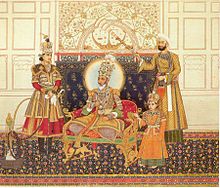Ghulam Ali Khan
This article needs additional citations for verification. (January 2014) |
Ghulam Ali Khan | |
|---|---|
| Born | |
| Died | c. 19th century |
| Known for | Topographical paintings, portraits |
| Notable work |
|
| Style | Company style |
Ghulam Ali Khan was a nineteenth century Indian painter in Delhi.[1] His painting career took place over the course of more than four decades, from 1817 to 1852.[2] He was the last royal Mughal painter, and also painted in the Company style for British patrons.[3]
Early life
[edit]Ghulam Ali Khan was born in the late eighteenth century.[4] At this time, Shah Alam II presided over the Mughal Empire, but in 1803 the British occupied Delhi.[5] Khan grew up and worked in a society that included Mughal and British cultures. He was the nephew of noted Mughal painter, Ghulam Murtaza Khan.[6]
Career
[edit]
Ghulam Ali Khan was the court painter of Mughal emperors Akbar II (reigned 1806–1837 CE) and Bahadur Shah II (reigned 1837–1858 CE) in Delhi.[4] As well as working for the royal Mughal court, Ghulam Ali Khan received commissions from British officers in the East India Company -- particularly Colonel James Skinner and officer William Fraser -- and from regional courts, such as the court of Jhajjar and Alwar. His artwork conveyed picturesque aesthetics and incorporated a Mughal painting style (such as in royal portraiture)[5] with the more European Company Style.
Painting Members of the Mughal Court
[edit]
In the nineteenth century there was a shift in Mughal manuscript iconography that gave greater emphasis to architectural representation.[5] The first artwork attributed to Ghulam Ali Khan is The Diwan-i Khan in the palace in the Delhi Fort [Red Fort] from 1817.[4] The red tent in this watercolor serves as a stand-in for the emperor in his absence. He was a formal court painter since 1827 when he produced portraits for Akbar II and his son Mirza Salim.[2] Khan signed these two portraits as "His Majesty's Painter" and "His Majesty's devoted faithful servant."[4] A decade later in 1837 Khan painted the accession portraits of Bahadur Shah with his sons[2] where they are set against the backdrop of the fireplace from the Zafar Mahal.[7] He collaborated on the Portraits of the Exalted Emperors, producing the visual imperial genealogy in 1851.[4] Other subject matter included painting high class courtesans, tawaifs, such as those featured in Mirza Fakhruddin entertained by musicians in a salon at the Zafar Mahal, 1852.[2]
Painting Beyond the Mughal Court
[edit]In 1827, Khan worked on a three-part painting series for Colonel Skinner memorializing portraits of Skinner's cavalry for a private album.[4] These paintings were done in watercolor and gouache.[2] Khan painted for Skinner again completing a portrait of the colonel in 1830.[4] He participated in the Fraser Album project which was a collection of Delhi genre paintings.
Ghulam Ali Khan's patronage continued expanding beyond Delhi especially in the 1840s.[2] From 1840-1853, Khan participated in the illuminating of the Gulistan (also known as the Golestan) manuscript for the Raja of Alwar. In the meantime, from 1840-1845 Khan also completed the watercolor of the Alwar gaddi for Banni Singh.[4] He painted other commissions for the Alwar court, and he taught at the Alwar school of painting. His compositions featured the Nawab'Abd al-Rahman Khan (e.g. Nawab 'Abd al-Rahman Khan in court with the envoy of the Raja of Alwar, Capt. Alexander Heatherly, 1852) and the Nawab of Jhajjar (such as in Nawab of Jhajjar astride a pet tiger, 1849-50).[2]
Works
[edit]-
A tiger hunt, 1820 (Victoria & Albert Museum)
-
Thakur Dawlat Singh among Courtiers, 1825 (David Collection)
-
View of the Red Fort, from Sketches of The Delhee Palace & Delhee, 1854
-
Kala, the Sepoy, with Saber Drawn and in Uniform. Two miniatures from the Fraser Album, from the workshop of Ghulam Ali Khan Family. Delhi, 1815-1816. The David Collection
-
Five Recruits - Ummee Chund, Indur, Goolzaree, Kukhtawur, and Juhaz; from the Fraser Album, ca. 1816 (Freer Gallery)
-
Portrait of Akbar II, 1827 (British Library)
See also
[edit]References
[edit]- ^ William Dalrymple. "William Dalrymple on The Dehlie Book | Art and design". The Guardian. Retrieved 20 February 2014.
- ^ a b c d e f g Losty, Jeremiah. "Two Important Late Mughal Group Portraits". Booklet published by Oliver Forge and Brendan Lynch, London, 2014.
- ^ "Scenes From a Dying Empire". The New York Times. Retrieved 20 February 2014.
- ^ a b c d e f g h Sharma, Yuthika. "In the Company of the Mughal Court, the Delhi Painter Ghulam Ali Khan". W Dalrymple and Y Sharma, Eds. Princes and Painters in Mughal Delhi 1707-1857, Yale University Press.
- ^ a b c Dadlani, Chanchal B. (2019). "Chapter 5: Mughal Architecture Between Manuscript and Print Culture". From Stone to Paper: Architecture as History in the Late Mughal Empire. New Haven: Yale University Press. doi:10.37862/aaeportal.00054.009. ISBN 978-0-300-25096-1. OCLC 1119732043.
- ^ Vakkalanka, Harshini (6 February 2013). "Art and an empire". The Hindu. ISSN 0971-751X. Retrieved 20 February 2014.
- ^ Paliwal, Amita (2014). "ZAFAR MAHAL: EXPLORING THE HISTORY OF LATE MUGHAL ARCHITECTURE". Proceedings of the Indian History Congress. 75: 1081–1089. ISSN 2249-1937.
Further reading
[edit]- Leach, Linda York (1998). Paintings from India. Nour Foundation. p. 1610163. ISBN 978-0-19-727629-7.
- Dalrymple, William (15 July 2013). Princes and Painters: In Mughal Delhi 1707-1857. Penguin Books Limited. pp. 41–51. ISBN 978-93-5118-173-6.
- Losty, Jeremiah P.; Roy, Malini (2012). Mughal India: Art, Culture and Empire : Manuscripts and Paintings in the British Library. British Library. pp. 217–220. ISBN 978-0-7123-5871-2.
External links
[edit]![]() Media related to Ghulam Ali Khan at Wikimedia Commons
Media related to Ghulam Ali Khan at Wikimedia Commons






